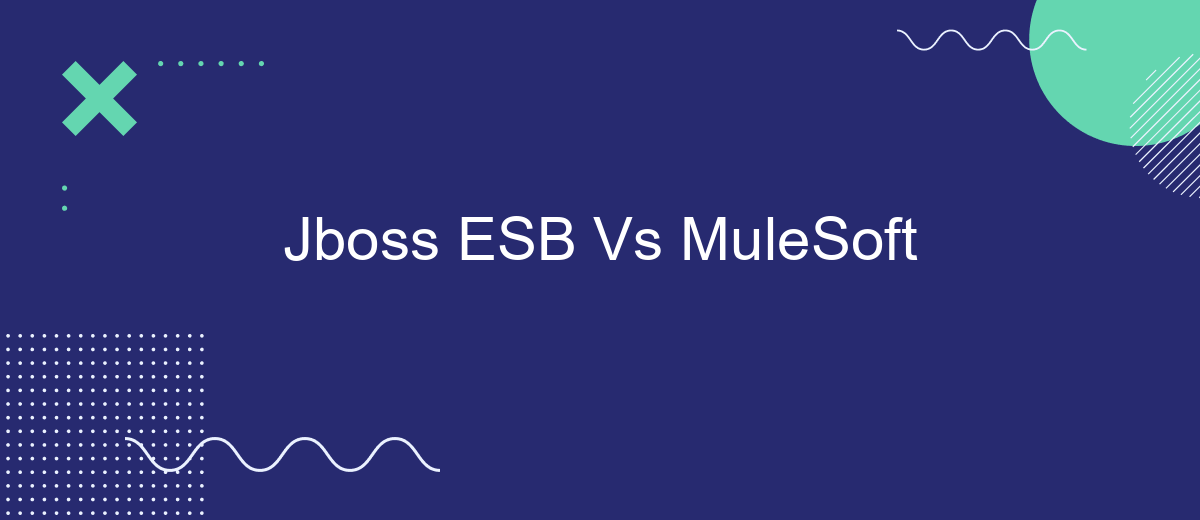When it comes to integrating diverse applications and services within an enterprise, choosing the right Enterprise Service Bus (ESB) is crucial. JBoss ESB and MuleSoft are two leading contenders in this space, each offering unique features and capabilities. This article aims to compare JBoss ESB and MuleSoft, examining their strengths, weaknesses, and suitability for various integration scenarios.
Introduction
In today's fast-paced business environment, seamless integration between various applications and services is crucial for operational efficiency. Two prominent players in the integration space are JBoss ESB and MuleSoft. Both platforms offer robust solutions for integrating disparate systems, automating workflows, and ensuring data consistency across the enterprise.
- JBoss ESB: An open-source enterprise service bus that provides a comprehensive set of tools for building, deploying, and managing integration solutions.
- MuleSoft: A widely-used integration platform that offers a suite of tools for connecting applications, data, and devices with APIs.
Choosing the right integration platform depends on various factors, including specific business needs, existing infrastructure, and budget constraints. Additionally, services like SaveMyLeads can further simplify the integration process by automating data transfer between different applications, enhancing overall efficiency. This article will delve into the features, strengths, and weaknesses of JBoss ESB and MuleSoft to help you make an informed decision.
Key Features and Capabilities

Jboss ESB offers a robust, enterprise-grade integration platform that supports a variety of protocols and data formats. It excels in providing a seamless environment for developing, deploying, and managing ESB-based applications. Key features include support for complex event processing, message transformation, and routing capabilities. Additionally, it integrates well with other JBoss middleware solutions, providing a cohesive ecosystem for enterprise applications.
MuleSoft, on the other hand, is renowned for its flexibility and extensive connectivity options. It supports a vast array of connectors, making it easier to integrate with numerous systems and services. MuleSoft's Anypoint Platform provides a unified solution for API management, design, and analytics. Notably, services like SaveMyLeads can be easily integrated into MuleSoft, allowing businesses to automate lead management and streamline workflows efficiently. Both platforms offer robust security features, ensuring the safe transfer and processing of data.
Architecture and Implementation

When comparing JBoss ESB and MuleSoft, it’s essential to understand their architecture and implementation. Both platforms offer robust solutions for enterprise service bus (ESB) capabilities, but they differ in their approaches and tools.
- JBoss ESB: This open-source platform leverages Java EE standards and integrates seamlessly with JBoss Application Server. It uses a service-oriented architecture (SOA) and provides various components such as listeners, routers, and actions to facilitate message routing and transformation.
- MuleSoft: Known for its Anypoint Platform, MuleSoft offers a comprehensive integration solution. It supports a wide range of connectors and pre-built templates, making it easier to integrate with various systems. MuleSoft’s architecture is based on event-driven and API-led connectivity, allowing for flexible and scalable integrations.
Both JBoss ESB and MuleSoft offer powerful tools for implementing integrations. For instance, services like SaveMyLeads can further simplify the process by providing automated lead data synchronization across multiple platforms. This ensures that businesses can maintain seamless communication and data flow between their applications, enhancing overall efficiency and responsiveness.
Use Cases and Applications

Jboss ESB and MuleSoft are widely used platforms for enterprise integration, catering to diverse use cases and applications. These platforms facilitate seamless communication between disparate systems, enabling organizations to streamline their operations and improve efficiency.
One of the primary use cases for Jboss ESB and MuleSoft is the integration of various business applications, such as CRM, ERP, and HR systems. By leveraging these tools, companies can ensure that data flows smoothly between different departments, reducing manual data entry and minimizing errors. Additionally, both platforms support real-time data processing, which is crucial for applications that require immediate data synchronization.
- Automating workflows between marketing and sales tools
- Synchronizing customer data across multiple platforms
- Integrating IoT devices with enterprise systems
- Facilitating B2B transactions and data exchanges
Services like SaveMyLeads can further enhance the capabilities of Jboss ESB and MuleSoft by providing ready-to-use integrations with popular platforms. This allows businesses to quickly set up and manage their data flows without extensive coding or technical expertise. By leveraging such services, organizations can achieve faster time-to-market and greater agility in their operations.
Comparison and Evaluation
When comparing JBoss ESB and MuleSoft, it is essential to consider their integration capabilities, performance, and ease of use. JBoss ESB, an open-source enterprise service bus, offers robust integration solutions for Java-based applications. It excels in environments where cost-effectiveness and flexibility are priorities. However, it may require more technical expertise to set up and maintain. On the other hand, MuleSoft, a commercial solution, provides a comprehensive integration platform that supports a wide range of protocols and technologies. Its intuitive interface and extensive documentation make it accessible for users with varying levels of technical expertise.
In terms of performance, MuleSoft often outperforms JBoss ESB due to its optimized architecture and built-in connectors. Additionally, MuleSoft's Anypoint Platform offers advanced features such as API management, analytics, and monitoring, which are crucial for large-scale integration projects. Services like SaveMyLeads can further enhance the integration experience by automating data workflows between various applications. While JBoss ESB is a solid choice for specific use cases, MuleSoft's versatility and user-friendly approach make it a more attractive option for businesses seeking a scalable and efficient integration solution.


FAQ
What are the primary differences between JBoss ESB and MuleSoft?
Which platform is more suitable for large-scale enterprise integrations?
How do JBoss ESB and MuleSoft handle API management?
What are the costs associated with using JBoss ESB and MuleSoft?
Can both JBoss ESB and MuleSoft be used for automating workflows and integrating SaaS applications?
Are you using Facebook Lead Ads? Then you will surely appreciate our service. The SaveMyLeads online connector is a simple and affordable tool that anyone can use to set up integrations for Facebook. Please note that you do not need to code or learn special technologies. Just register on our website and create the necessary integration through the web interface. Connect your advertising account with various services and applications. Integrations are configured in just 5-10 minutes, and in the long run they will save you an impressive amount of time.
